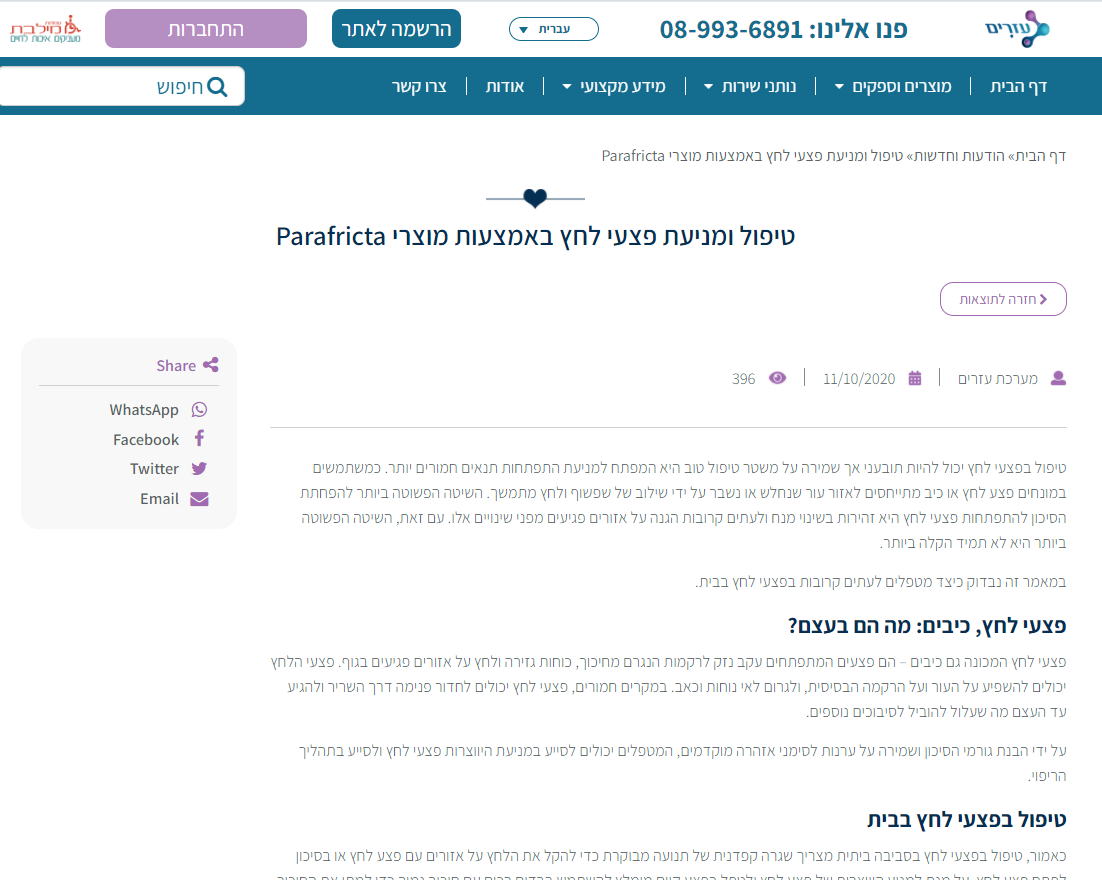Treatment and prevention of pressure ulcers using Parafricta products

Treatment of pressure ulcers can be demanding but maintaining a good treatment regimen is the key to preventing the development of more severe conditions. When using the terms pressure sore or ulcer refer to a skin area that is weakened or broken by a combination of rubbing and continuous pressure. The simplest method of reducing the risk of developing pressure ulcers is to be careful in changing posture and often protecting vulnerable areas from these changes. However, the simplest method is not always the easiest. In this article we will look at how pressure ulcers are often treated at home.
Pressure ulcers, ulcers: what exactly are they?
Pressure ulcers also known as ulcers - are wounds that develop due to tissue damage caused by friction, shear forces and pressure on vulnerable areas in the body. Pressure sores can affect the skin and underlying tissue, causing discomfort and pain. In severe cases, pressure sores can penetrate through the muscle and reach the bone which can lead to further complications. By understanding the risk factors and maintaining vigilance for early warning signs, caregivers can help prevent the formation of pressure sores and aid in the healing process.
Treatment of pressure ulcers at home
As mentioned, treating pressure sores in a home environment requires a strict routine of controlled movement to relieve pressure on areas with pressure sores or at risk of developing pressure sores. In order to prevent the formation of a pressure sore and treat an existing wound it is recommended to use soft fabrics with low friction to moderate the friction and shear forces caused as a result of these movements and create or aggravate the pressure sores. This will be assisted by various Parafricta products made from a fabric with a low coefficient of friction and adapted to different body areas. The range of products produced are: sheet, heel protector, bottom or pillowcase that allow you to change position in bed easily and comfortably without damaging areas of the body that are at risk, such as the heel, pelvis, shoulders. Ensuring posture change at regular intervals and careful posture change that includes the use of low-friction fabrics is the basis for any pressure ulcer treatment plan. Sitting for extended periods, it is recommended to move once every fifteen minutes. Most grade 1 and 2 pressure sores can be successfully treated at home, by adhering to a careful change of posture, using fabric products with low friction and a strict hygiene regime. Wounds of excessive severity may require treatment in a hospital or sheltered housing.
Treatment of pressure ulcers with Parafricta products
Parafricta manufactures low friction fabric on which it has patented. This is a comfortable silk-like fabric that is pleasant to the touch. The company manufactures a variety of products from this fabric, the common denominator of which is that it is a simple and easy solution for application that has been research-proven in long-term studies (over five years) as reducing the formation of pressure sores by 84%. Parafricta is worn on the mattress and thus all the organs of the body come in contact with it. Because all the organs of the body come in contact with it, it prevents the formation of a pressure sore and treats an existing wound throughout the body. The sheet replaces the sheet the patient is sleeping on today. The sheet is adapted to the type and size of the patient's bed and is washable and reusable. Because the sheet is made of smooth fabric, it significantly facilitates a change of position in the bed and is also defined as mobility assistance. The sheet facilitates a change in posture even for people who are limited in movement but still manage to turn over but this requires a lot of effort from them. Using the sheet the effort required of them to change position in bed will be significantly reduced. People who have tried the sheet did not believe how much such a simple sheet replacement solution can ease them in the effort required to change position in bed. In addition the sheet makes it easier for someone to take care of people who cannot change position on their own and need the help of another person. We know that the effort required to make a person who can not turn over on his own is very large and we know that in order to prevent a pressure sore it is important to turn it over at least once every two hours. Because less force is applied it will relieve the pressure and pain exerted on a person turning it. We received relief for both the patient and the therapist. The pillowcase is also a simple solution of replacing a standard pillowcase with a Parafricta pillowcase. The pillowcase helps prevent pressure sores and heals existing wounds in the ears or scalp. The uniqueness of the heel protector (ankle sock) is in its comfort. Unlike heel protectors that are sold in the market today and are swollen and very uncomfortable for the patient and fixate his foot without the ability to move it. The Parafricta ankle sock allows movement of the foot and is very easy to pull on and remove even more than a regular sock. Ankle sock is available in a variety of sizes and is tailored to the size of the patient's shoes. And is intended to prevent the formation of a pressure sore in the pelvis or to treat an existing wound. It is available in a variety of types suitable for women and men and in a variety of sizes and of course it is washable and reusable. The bottom is also suitable for people who do not control their needs and use a diaper. If you want more information about the use of Parafricta fabrics to help treat pressure sores at home, contact Medtex, a company that markets the products in Israel. This information is for general advice only.
